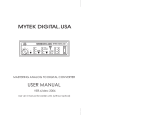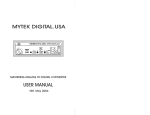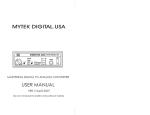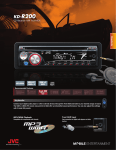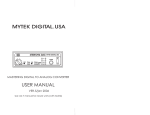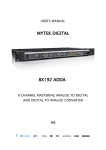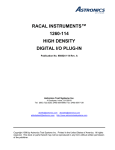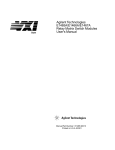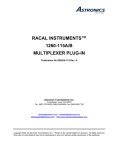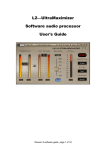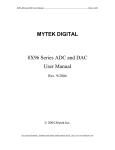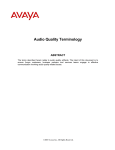Download USER MANUAL
Transcript
MYTEK DIGITAL.USA MASTERING ANALOG TO DIGITAL CONVERTER USER MANUAL VER.5/2005 Quick Start……………………………………………….3 Introduction..…………………………………….............4 This manual may be updated Operation- Internal jumper settings........................……...5 Download the newest version at: Operation- Typical setup -Balanced Signal Source……...7 http://www.mytekdigital.com/manuals/stereo96adc_manual.pdf Operation- Analog input alignment……………...………9 Operation- Unbalanced Signal Source…….......................10 For technical support, technical tips and support check: Sampling frequencies and External synchronization…....12 http://www.mytekdigital.com/products/stereo96adc.htm SuperShaper-HR ™ Noise shaping and dithering…..........14 or contact Mytek tech support at: Rack mount shelf.......................................….....................17 [email protected] Companion Stereo96 DAC…………………………….....18 Specifications…………………………………………......19 or at: Warranty conditions……………………………………...20 tel. (646)-613 1822 fax.(212)-202 5331 Mytek 151 Lafayette Street 3rd Fl New York NY 10013 USA 1 2 Input volume knob sets the input sensitivity with range from mute to +4dB=-10dBFS. This is factory default. The knob can be disabled with internal jumpers which can select either the knob or internal precision 10 turn trimpots. Refer to "Internal jumper settings" for details. Sample rate selection. Sets the desired sample rate. When used with external clock select FS closest matching that of supplied external wordclock. Selects output wordlength as stated. The 20 and 16 bit "flat dither" setting corresponds to signal dithered with flat dither. Supershaper HR is a high performace wordlength reduction algorithm similar to Pow-r(tm). Flat dither is recommended for multitracking, while Supershaper can be used for printing final mix to CD-R. Line power is 115VAC/50/60Hz (factory default) or 230VAC/50/60Hz switchable by internal switch accessible after removing the top cover. 1 Amp slow blow 20mm fuse is also accessible under the cover. Introduction to Stereo96 Series Converters Peak meter in -dBFS. The red LED marked "0" corresponds to 1 sample overload. The MYTEK Stereo96 series consists of two 1/3 rack units- the Stereo96 ADC and the Stereo 96 DAC. They are also a part of extended family of 1/3 rack units which also includes 192kHz capable converters, SRC and Studio Clock. Stereo96 converters can be used as stand-alone devices for variety of studio applications such as mastering, recording and playback, whenever the highest quality conversion is required. Internal sync provides the best clock stability (10ps) and thus the best conversion. External sync is intended for complex systems. It can be a standard wordclock signal or Protools (tm) 256X superclock. Refer to "Internal jumper settings" for details. Since internal clock generator is top notch, there is no sonic benefit from clocking Stereo96ADC externally. Wordclock input (factory default) can be set to alternatively accept 256 Protools (tm) Superclock (Mix systems). Refer to "Internal jumper settings" for details. 75 Ohm termination (default off) can also be set inside unit. Analog inputs accept a range of signals from +4dB balanced down to consumer unbalanced. Refer to "Internal jumper settings" for details. Users choose Mytek 8X96 converters primarily for their outstanding sound quality. The sound of Mytek converters can be described as "transparent". We design our converters to be as faithful to the signal as possible, rather than the philosophy of some other manufacturers who offer "analog" or "tube" sounding converters. Mytek converters are closest to a straight wire, which is especially evident when used at full 24/96 resolution. Sonically they are equal or better than the most expensive mastering converters. Even when used in 16 bit mode, the Stereo96 converters produce 20dB (10 times) less distortion than typical converters found in budget recording equipment. On Mytek website you can find and download various sound samples to evaluate Stereo96 series sound quality and compare it to the sound of other high end converter units. To download samples log onto: http://www.mytekdigital.com/listening_tests.htm Stereo96 ADC features include: Wordclock output provides high current drive and a very stable low jitter clock. It can be used as a superior house clock to clock or synchronize other digital equipment. Running Stereo96ADC on internal clock and slaving the rest of equipment to Mytek clock is the recommended setting for best sonic performance. AES/EBU and SPDIF outputs are simultaneous. They operate in "single wire" mode for all sampling frequencies. These outputs can be used to externally clock other equipment with the same effect as wordclock output. Clocking via AES/EBU line is recommended especially when cables are very long (over 20ft). 3 - 44.1, 48, 88.2 and 96kHz internal sampling frequencies Ext. wordclock sync 25-100kHz or 256x Superclock(tm) 120dB Dynamic Range 24 bit resolution High performance SuperShaper-HR™ psychoacoustic noiseshaping algorithm for 16 bit output Switchable precision 10 turn-trimpots or input gain knob Wordclock output can be used as a hi-end house clock. 4 Stereo96ADC internal trimpots and jumper assignments (remove top cover to access) Stereo96ADC internal trimpots and jumper assignments (remove top cover to access) Jumper JP5: Wordclock input 75 Ohm termination. Connect this jumper when Stereo96 ADC is the last destination in a chain fed by external wordclock source and the cable is long (above 6ft). For short cables and wordclock sources with unknown drive capability JP5 should be left unconnected (unterminated) (retain the jumper on one pin only). DIPSWITCH SW4 : Sets the clock mode on BNC in/out SW1- "ON", wordclock =FS/2 for 88.2 and 96k (FS for 44.1 and 48k) SW1- "OFF", wordclock =FS for all sampling rates SW2- "ON", output and input becomes Superclock=256 x FS (for use with Protools(R) Mix systems and 44.1 and 48k only) Jumpers J1 and J2- Set the input to unbalanced. The unbalanced signal should be fed between pin 2 (signal) and pin 1 (shield) of the input XLR. Pin 3 must be left unconnected. You can use a standard RCA<>XLR adapter, but make sure connection to pin 3 is cut inside the adapter. Jumpers JP2,JP4,JP1,JP3 should be removed (retain the jumper on one pin only). In this mode the sensitivity of the input stage is fixed and cannot be adjusted within the converter (adjust level prior to feeding the converter). This mode is recommended only in situations when no professional balanced signal source is available. This also works with -10dBV (consumer level). 115VAC/230VAC power switch JP1 and JP3 - Balanced input at +4dBm (professional level). JP1 and JP3 -these jumpers insert the 10 turn precision trimpots (RN2 and RN3) for both left and right analog inputs. These trimpots determine the +4dBm headroom of the ADC. The setting can be anywhere from -14dBFS to -20dBFS, typical being 15 or -16 for most of other digital equipment (or -18 to comply with AES level standard). Refer to “Analog input level” Chapter for alignment procedure details. These jumpers should normally be removed (retain the jumper on 1 pin only) if input potentiometer is engaged, but can also be used in parallel with the pot- using both pot and trimpots will result in lower input sensitivity with advantage of precise L/R matching. JP2 and JP4 - Balanced input at +4dBm (professional level). JP2 and JP4 these jumpers insert the input volume conductive plastic potentiometer for both left and right analog inputs -this setting mimics a typical DAT machine input volume knob and can be used for remote recording and other applications where the input level is vaguely defined and needs to be instantly adjusted. The pot also allows for live fade-in and out. The pot is not recommended for regular studio use as the L/R sensitivity cannot be set as precisely as with trimpots because of the mechanical accuracy of the pot. These jumpers should normally be removed (retain the jumper on one pin only) if trimpots are engaged, although parallel operation is possible (see above) 5 T1 Amp 20mm Slow Blow fuse 6 Typical Setup Balanced signal source Stereo96 ADC is equipped with 2 XLR analog inputs. For best signal to noise performance it is recommended the signal source has a typical low impedance output with standard +4dB line level balanced signal. Alternatively a weaker unbalanced signal source can be used as described in subsequent paragraph. In typical setup the ADC is running on its internal clock with the rest of equipment synchronized to Mytek clock either through digital output signal or wordclock. In this configuration Mytek ADC serves as a very stable low jitter house clock which increases the integrity and robustness of the rest of the system. Because of careful design this clock is as good or better than dedicated studio clock generators. Unlike in lesser quality equipment there is no sonic benefit in clocking Mytek ADC externally. In case of such operational need refer to "Sampling frequencies and external synchronization". The wordclock source can be terminated with internal 75 Ohm resistor inside the Mytek unit (see: "Internal jumpers"). The termination is recommended when using long wordclock cables (above 10 ft) and when the wordclock source is capable handling such termination. Do not terminate if the source is not capable of high current drive or cable is short. 4. Select sampling frequency. If wordclock/superclock is used the sampling frequency has to correspond to external clock frequency (can be multiple, see: "Internal jumpers") 5. Select output wordlength- 24 bit full output is recommended. 16 and 20 bit output are meant to be used when the destination (recorder such as CDR, ADAT tape machine) limits the wordlength. 20 bit output is dithered with flat dither. 16 bit output can either be dithered flat (recommended for multitrack recording) or 16 bit noiseshaped (recommended for final masters, printing to CDR or DAT machine). The Supershaper HR (tm) used for 16 bit wordlenght reduction is a sophisticated 9th order noise shaper with dither, similar in operation to Pow-r #3 (tm) noise reduction algorithm (see: "Supershaper HR..."). Setup for typical balanced operation includes following steps: 1. Setup the unit using external jumpers to: a. Balanced inputs fed through input knob (factory default). This mode is recommended for casual use where the input level is vaguely defined and needs to be quickly adjusted with input knob. or: b. Set the jumpers to balanced inputs fed through precision 10-turn trimpots. Then perform "analog input alignment" as described in the next chapter. 6. Synchronize the destination either to digital input sync or to wordclock sync, depending on system configuration. The quality of recorded signal does not depend on how the digital destination is synchronized with Mytek AD converter. 7. Record- adjust input level with knob or by adjusting level at the source. Unless you are printing final CD master, we do not recommend recording too hot. There is no sonic benefit of pushing the level up to 0dBFS. A healthy 1-2-3 dBs headroom allows more freedom in later processing and mixing of recorded tracks. The red peak light is triggered digitally when 1 or more samples are overload. It's not recommended to peak frequently although occasional overloads might be acceptable. 2. Setup all other connections. 3. Select desired clock source (sync), either internal or external. If external wordclock or superclock source is required for systemic reasons, setup its mode using the DIP switch as described in "Internal jumpers". 7 8 Unbalanced Signal Source Operation Analog Input Alignment When using internal trimpots analog input level needs to be aligned using an approx 1kHz sinewave fed from +4dB balanced source. The alignment does not affect audio quality, only input sensitivity. The alignment is performed using 10 turn trimpots inside the unit (see: "Internal Jumpers"). A small tweaker or screwdriver is necessary. You have to arbitrarily decide what will be your studio "0 VU" analog/digital reference level. It is usually between -20 and -14dB. It defines how much headroom you have left over the normal operating "0 VU" level. You may set it at the same level as other piece of equipment in your studio. For example Panasonic 3700 is fixed at -18dB (which is low for most rock and roll recordings). ADAT is fixed at -15dB which is a typical optimal level. Stereo96ADC can be operated with weaker consumer level unbalanced signal sources. Follow these steps in such case. 1. Unbalanced cable used to feed the unit must have signal connected to pin 2 of XLR, ground (shield) connected to pin 1 and while 3 must be disconnected. Wrong wiring of this cable can cause improper operation resulting in elevated distortion or noise. 2. Set the jumpers to "unbalanced" and disconnect both the trimpots and potentiometer. This sets the converter to its hights sensitivity (approx 10dB FS). 3. Setup all other connections. 1.Set the oscillator in your console at 1kHz and "0 VU". Send the oscillator to the ADC analog input."0 VU" at + 4dB corresponds to 1.225 Volts RMS measured between pin 2 and 3 of the output XLRs. If you do not have an analog oscillator, you can use a calibrated analog out of a DA converter and generate the sinewave inside the DAW. 2. Connect a digital PEAK meter to a digital output. If you don't have a dedicated digital meter use the most precise meter available in you existing digital recording equipment or DAW. 3. Adjust the analog input level to get appropriate reading of the meter (for example -15dB). 4. Select desired clock source (sync), either internal or extrenal. If external wordclock or superclock source is required for systemic reasons, setup its mode using the DIP switch as described in "Internal jumpers". The wordclock source can be terminated with internal 75 Ohm resistor inside the Mytek unit (see: "Internal jumpers"). The termination is recommended when using long wordclock cables (above 10 ft) and when the wordclock source is capable handling such termination. Do no terminate if the source is not capable of high current drive or cable is short. 4. Select sampling frequency. If wordclock/superclock is used the sampling frequency has to correspond to external clock frequency (can be multiple, see: "Internal jumpers") The alignment has to be performed with accuracy of 0.1dB to be considered accurate. Similar alignment procedure with 0.1dB accuracy is required for valid A/B listening comparisons btwn. different pieces of equipment. A slightly louder source is typically perceived as "better" sounding. 9 5. Select output wordlength- 24 bit full output is recommended. 16 and 20 bit output are meant to be used when the destination (recorder such as CDR, ADAT tape machine) limits the wordlength. 20 bit output is dithered with flat dither. 16 bit output can either be dithered flat (recommended for multitrack recording) or 16 bit noiseshaped (recommended for final masters, printing to CDR or DAT machine). 10 The Supershaper HR (tm) used for 16 bit wordlength reduction is a sophisticated 9th order noise shaper with dither, similar in operation to Pow-r #3 (tm) noise reduction algorithm (see: "Supershaper HR..."). 6. Synchronize the destination either to digital input sync or to wordclock sync, depending on system configuration. The quality of recorded signal does not depend on how the digital destination is synchronized with Mytek AD converter. 7. Record- adjust input level by adjusting level at the source. Unless you are printing final CD master, we do not recommend recording too hot. There is no sonic benefit of pushing the level up to 0dBFS. A healthy 1-23 dBs headroom allows more freedom in later processing and mixing of recorded tracks. The red peak light is triggered digitally when 1 or more samples are overload. It's not recommended to peak frequently although occasional overloads might be acceptable. Sampling frequencies and External Synchronization In typical setup the ADC is running on its internal clock with the rest of equipment synchronized to Mytek clock either through digital output signal or wordclock. In this configuration Mytek ADC serves as a very stable low jitter house clock which increases the integrity and robustness of the rest of the system. Because of careful design this clock is as good or better than dedicated studio clock generators. Unlike in lesser quality equipment there is no sonic benefit in clocking Mytek ADC externally. Mytek internal clock generator is situated within inches of converter chip and it will always provide a better jitter performance (approx 10ps) than any external source which is inherently compromised by cable connections. If external wordclock or superclock source has to be used for systemic reasons, the Stereo96ADC clock generator will lock to external source and use a stabilizing PLL circuit to reduce incoming clock jitter before it reaches the actual AD circuit. Stereo96ADC can be operated with any of 4 standard sampling frequencies or at any frequency btwn. 30k-100k when supplied with external clock source. The measurable audio band performance (Dynamic Range) stays virtually the same within all these frequencies. 44.1k will be typically used for printing final master. 48k is recommended for digital video production. The two higher sampling rates are recommended for discerning users requiring uncompromised sound quality. In this mode the ADC features a 40kHz bandwidth (instead of 20k) which allows for improved transient response of recorded music as well as minimized the impact of brick wall antialiasing digital filters on the upper audio band. The end effect of hisampling recording is a more "analog feel" and easiness of sound and more natural sounding instruments especially percussion or cymbals. A decision of choice btwn. 88.2k or 96k should be made based on the project flow- there might be arguments for one or the other. For example 88.2k may convert to 44.1k with less damaging SRC process, if such process is available. Most ubiquitous software SRCs are not very good 11 12 and must not be used for critical projects downsampling. Some such as Faulkner Downsampler (http://www.audiosignal.co.uk/freeware.html) provide excellent results for 88.2>44.1 but don't work for 96k. 88.2k is also easier to upsample to DSD. 96k sample rate, has in our opinion, a marginally better perceived sound quality than 88.2k but the difference is very small and difficult to perceive for most people. If the record is going to be mixed in analog domain, 96k might be a desirable choice for tracking. Mytek “SuperShaper-HR” ™ Noise Shaping and Dither The Stereo96 A/D converter employs SuperShaper-HR ™ - a sophisticated psychoacoustically optimized noise shaping and dithering algorithm. SuperShaper-HR ™ uses 9th order high resolution noise shaping filters with proprietary filter coefficients developed by Mytek Inc. The appropriate noiseshaping curve is programmed into noiseshaping filters. This feature allows for preserving most of 24 bit performance in 16 bit data output. 60dB Effective 19 bit performance 50dB 40dB 30dB 20dB 10dB 0dB 16 bit noise level -10dB -20dB -30dB -40dB 0HZ 5k 10k 15k 20k 25k Noise shaper performance graphs at 16 bit output . When noise-shaping processing is on, the quantization noise is removed from the audio band, where the noise floor is kept as close as possible to the 24 bit level, and moved to the 20-22 kHz range. The noise-shaping filters are automatically engaged at appropriate levels when 16 bit output marked "Supershaper HR" is selected. If 24 or 20 bit bit output is selected, the noise-shaping filter is off. 13 14 More information about use of noise shaping in high resolution recording can be found in the following Audio Engineering Society Preprints ( http://www.aes.org ): “Optimal Noise Shaping and Dither of Digital Signals” “Coding Methods for High Resolution Recording Systems” Preprint Number: 2822 Convention: 87 1989-10 Author: Michael Gerzon Author: Peter G. Craven Preprint Number: 4639 Convention: 103 1997-09 Author: J. Robert Stuart This paper discusses optimizing noise shaping, with or without dither, using filtered error-feedback round a quantizer. This paper reviews the recording and reproduction chain from the viewpoints of digital audio engineering and psychoacoustics. It also attempts to define the audio requirements of a transparent digital audio channel. The theory and practice of selecting high sample rates such as 96kHz and word lengths of up to 24 bits are examined. The relative importance of sampling rate and word size at various points in the recording, mastering, transmission, and replay chain is discussed. “Dynamic Range Enhancement Using Noise-Shaped Dither at 44.1, 48, and 96 kHz” Preprint Number: 4236 Author: J. R. Stuart Author: R. J. Wilson “Psychoacoustically Optimal Noise Shaping” Preprint Number: 2965 Convention: 89 1990-09 AES Journal Vol:Issue: 40:7/8 Page: 611 Year: 1992 Author: Robert A. Wannamaker This paper examines the design of psycho-acoustically optimal noise shaping filters for requantization in non-oversampling digital audio applications. Convention: 100 1996-05 This paper presents an overview of the work done on noise shaping, summarizing how noise shapers are designed, implemented and measured, and outlining the hearing model used to evaluate the various designs achieved. “Dynamic Range Enhancement Using Noise-Shaped Dither Applied to Signals with and without Preemphasis” Preprint Number: 3871 Convention: 96 1994-03 Author: Robert Stuart Author: Rhonda J. Wilson This paper presents new noise-shaped dithers designed to give increased subjective dynamic range when applied to signals with and without preemphasis. 15 16 Companion Stereo96 DAC Rack Mount Shelf The Stereo96 ADC is 1/3 rack space wide and 1U tall. Mytek provides a 1U rack mount shelf as accessory to mount up to 3 of 1/3 rack units. The units are attached to shelf with small screw connecting the shelf to bottom through a threaded hole on the bottom of the unit. 17 this page will be updated 18 Warranty Specifications This Stereo96ADC digital audio converter is warranted by Mytek to the original purchaser against defects in workmanship and materials used in manufacture for a period of one year from the date of purchase. Faults due to customer misuse, unauthorized modifications or accidents are not covered by this warranty. Conversion: Linear, 128x oversampling at 44.1/48kHz 64x oversampling at 88.2/96kHz Resolution: 24 bit Sample rates: 44.1kHz, 48kHz, 88.2kHz, 96kHz or wordclock 25-100kHz Dynamic Range: 120dB A-weighted, 117dB Total THD+Noise: -105dB (<0.0005%) Internal clock jitter: <10picoseconds Analog Inputs: +4dBm balanced or unbalanced, 10kOhm Digital outputs: Hi-speed (25-100kHz) AES/EBU and SPDIF External Sync.: Wordclock in and out. or 256x Superclock Wordlock Out used as house clock: 15 LS TTL loads max. Can be terminated. Mains: 100/115V-220/240V 50/60Hz switchable Dimensions: 1/3 rack space wide x 1U high x 8” deep (5.5”x 1.6”x 8”) Weight: 4 pounds No other warranty is expressed or implied. Any faulty unit should be sent, shipping prepaid, to the manufacturer service center. Prior to shipping the client should obtain from Mytek an RMA# for warranty services. Units sent without RMA# will not be accepted. Mytek extends affordable repair service for all units manufactured to date that are not covered by this Warranty. 19 20











